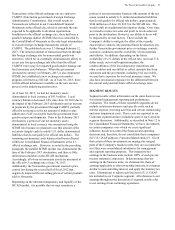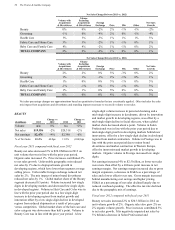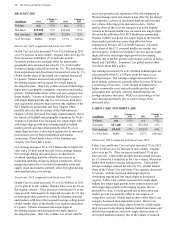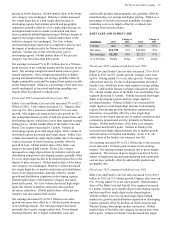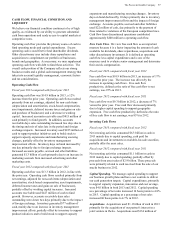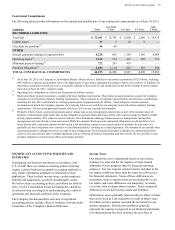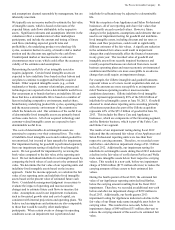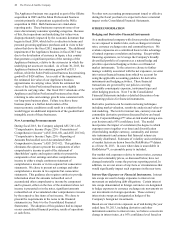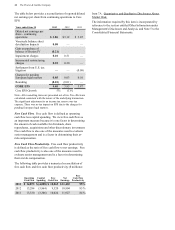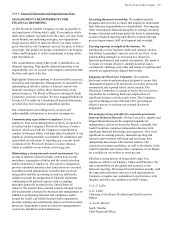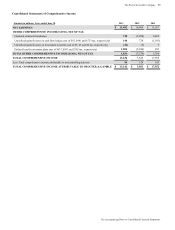Proctor and Gamble 2013 Annual Report Download - page 43
Download and view the complete annual report
Please find page 43 of the 2013 Proctor and Gamble annual report below. You can navigate through the pages in the report by either clicking on the pages listed below, or by using the keyword search tool below to find specific information within the annual report.The Procter & Gamble Company 41
and assumptions deemed reasonable by management, but are
inherently uncertain.
We typically use an income method to estimate the fair value
of intangible assets, which is based on forecasts of the
expected future cash flows attributable to the respective
assets. Significant estimates and assumptions inherent in the
valuations reflect a consideration of other marketplace
participants, and include the amount and timing of future
cash flows (including expected growth rates and
profitability), the underlying product or technology life
cycles, economic barriers to entry, a brand's relative market
position and the discount rate applied to the cash flows.
Unanticipated market or macroeconomic events and
circumstances may occur, which could affect the accuracy or
validity of the estimates and assumptions.
Determining the useful life of an intangible asset also
requires judgment. Certain brand intangible assets are
expected to have indefinite lives based on their history and
our plans to continue to support and build the acquired
brands. Other acquired intangible assets (e.g., certain
trademarks or brands, customer relationships, patents and
technologies) are expected to have determinable useful lives.
Our assessment as to brands that have an indefinite life and
those that have a determinable life is based on a number of
factors including competitive environment, market share,
brand history, underlying product life cycles, operating plans
and the macroeconomic environment of the countries in
which the brands are sold. Our estimates of the useful lives
of determinable-lived intangible assets are primarily based
on these same factors. All of our acquired technology and
customer-related intangible assets are expected to have
determinable useful lives.
The costs of determinable-lived intangible assets are
amortized to expense over their estimated lives. The value
of indefinite-lived intangible assets and residual goodwill is
not amortized, but is tested at least annually for impairment.
Our impairment testing for goodwill is performed separately
from our impairment testing of indefinite-lived intangible
assets. We test goodwill for impairment by reviewing the
book value compared to the fair value at the reporting unit
level. We test individual indefinite-lived intangible assets by
comparing the book values of each asset to the estimated fair
value. We determine the fair value of our reporting units and
indefinite-lived intangible assets based on the income
approach. Under the income approach, we calculate the fair
value of our reporting units and indefinite-lived intangible
assets based on the present value of estimated future cash
flows. Considerable management judgment is necessary to
evaluate the impact of operating and macroeconomic
changes and to estimate future cash flows to measure fair
value. Assumptions used in our impairment evaluations,
such as forecasted growth rates and cost of capital, are
consistent with internal projections and operating plans. We
believe such assumptions and estimates are also comparable
to those that would be used by other marketplace
participants. When certain events or changes in operating
conditions occur, an impairment test is performed and
indefinite-lived brands may be adjusted to a determinable
life.
With the exception of our Appliances and Salon Professional
businesses, all of our reporting units have fair values that
significantly exceed recorded values. However, future
changes in the judgments, assumptions and estimates that are
used in our impairment testing for goodwill and indefinite-
lived intangible assets, including discount and tax rates or
future cash flow projections, could result in significantly
different estimates of the fair values. A significant reduction
in the estimated fair values could result in impairment
charges that could materially affect the financial statements
in any given year. The recorded value of goodwill and
intangible assets from recently impaired businesses and
recently acquired businesses are derived from more recent
business operating plans and macroeconomic environmental
conditions and therefore are more susceptible to an adverse
change that could require an impairment charge.
For example, the Gillette intangible and goodwill amounts
represent values as of a more recent acquisition date and, as
such, the amounts are more susceptible to an impairment
risk if business operating results or macroeconomic
conditions deteriorate. Gillette indefinite-lived intangible
assets represent approximately 89% of the $26.8 billion of
indefinite-lived intangible assets at June 30, 2013. Goodwill
allocated to stand-alone reporting units consisting primarily
of businesses purchased as part of the Gillette acquisition
represents 42% of the $55.2 billion of goodwill at June 30,
2013. This includes the Shave Care and Appliances
businesses, which are components of the Grooming segment,
and the Batteries business, which is part of the Fabric Care
and Home Care segment.
The results of our impairment testing during fiscal 2012
indicated that the estimated fair values of our Appliances and
Salon Professional reporting units were less than their
respective carrying amounts. Therefore, we recorded a non-
cash before- and after-tax impairment charge of $1.3 billion
in fiscal 2012. Additionally, our impairment testing for
indefinite-lived intangible assets during fiscal 2012 indicated
a decline in the fair value of our Koleston Perfect and Wella
trade name intangible assets below their respective carrying
values. This resulted in a non-cash, before-tax impairment
charge of $246 million ($173 million after-tax) to reduce the
carrying amounts of these assets to their estimated fair
values.
During the fourth quarter of fiscal 2013, the estimated fair
value of our Appliances reporting units declined further,
below the carrying amount resulting from the fiscal 2012
impairment. Therefore, we recorded an additional non-cash
before and after-tax impairment charge of $259 million in
fiscal 2013. Additionally, our fourth quarter 2013
impairment testing for Appliances indicated a decline in the
fair value of our Braun trade name intangible asset below its
carrying value. This resulted in a non-cash, before-tax
impairment charge of $49 million ($31 million after-tax) to
reduce the carrying amount of this asset to its estimated fair
value.


